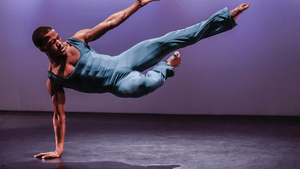Stay in the Loop
BSR publishes on a weekly schedule, with an email newsletter every Wednesday and Thursday morning. There’s no paywall, and subscribing is always free.
Full steam ahead (and back)
Philadanco presents 'Black Steam'

For Black Steam, Philadanco’s Spring 2017 series, the company presented four works: two world premieres by rising young choreographers, and two that showed the past still has something to tell us about dancing. For those who somehow don’t know of its many accolades, Philadanco, founded in 1970 by Joan Myers Brown, is one of the country’s premiere dance companies with African-American roots, and this performance featured some of Brown's favorite choreographers.
Social consciousness in art
The first dance of the night, “Box Out” by Dawn Marie Bazemore, began with three boxes onstage and used as its framework Nikki Giovanni’s poem “But Since You Finally Asked.” The boxes became a slave-auction block while the poem declared that no one asked enslaved Africans or their descendants what they thought of the Jamestown slave market or all the betrayals that followed. In a later section of the piece, called “Glass Ceiling” (my favorite), the boxes transformed into a workplace where five women, in the coveralls and kerchief made famous by World War II poster girl Rosie the Riveter, danced to the rhythms of factory machinery.
The second new piece of the night, Christopher L. Huggins’s “New Fruit,” expressed the tragedy of continued violence against black men in America. It began with a stunning solo by Joe Gonzales representing a 19th-century lynching, as the mournful song “Strange Fruit” played. It then moved on to the present day, with costumes (by Natasha Guruleva) that heightened an urban feel with bright-colored hoodies. The electric dancing fueled by a driving beat -- including a dance-off that contained echoes of Brazilian capoeira -- performed by Victor Lewis Jr. and Jah’meek D. Williams. Street life is exuberant -- and then a gunshot, a death. The piece’s final section, “This Bitter Land” (song by Nas with Erykah Badu) ended in sorrow, but also hope and defiance.
Both of these new pieces offered passionate ideas and used their dancers to create socially conscious art. But the company’s heritage pieces were satisfying and, in their own way, just as relevant.
Dancing it old school
Gene Hill Sagan’s “Sweet Agony” was my favorite piece of the night. First came the music of Teddy Pendergrass. Then Joe Gonzales entered in a blue bodysuit with a flowing blue coat (by Frankie Fehr) accompanied by three women, his coat accentuating the flow of their dance. Gonzales quickly became one of my favorite dancers in the city. Exuberantly sexy, “Sweet Agony” included various combinations, including several excellent pas de deux.
The final piece of the night, Talley Beatty’s “A Rag, A Bone, and a Hank of Hair,” set to music by Prince and Earth, Wind, and Fire, was a sensory explosion of speed, skill, color, and rock and roll. It filled the stage with strong women in flirty dresses and men challenging each other in displays of dancing skill, all performed at top speed. I don’t know how they survived it, but it was fun.
Philadanco features world-class stars. Not all the rest of the company’s dancers quite reach that level, but the overall performance brought vibrancy and passion. I’ll be watching for their next appearance.
What, When, Where
Black Steam. Philadanco. April 13-15, 2017, at the Kimmel Center's Perelman Theater, 300 S. Broad Street, Philadelphia. (215) 893-1999 or kimmelcenter.org.
Sign up for our newsletter
All of the week's new articles, all in one place. Sign up for the free weekly BSR newsletters, and don't miss a conversation.
 Camille Bacon-Smith
Camille Bacon-Smith